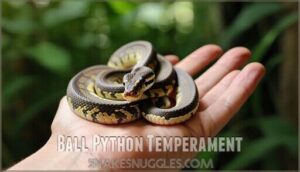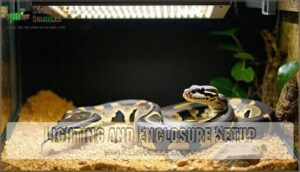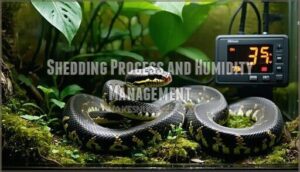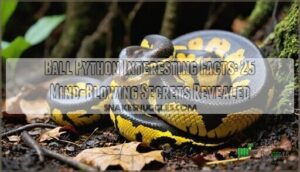This site is supported by our readers. We may earn a commission, at no cost to you, if you purchase through links.

You’ll notice your snake doing this when startled by sudden movements or loud noises.
They’re naturally shy creatures who prefer hiding during the day and becoming active at night.
Your ball python might also exhibit head-bobbing when curious, tongue-flicking to "taste" their environment, and remaining motionless for hours while hunting or resting.
They’re incredibly patient predators who can wait weeks between meals without stress.
Understanding these quirky habits helps you recognize when your snake feels secure versus anxious, making care much easier.
Table Of Contents
- Key Takeaways
- Ball Python Behavior
- Ball Python Temperament
- Ball Python Environmental Needs
- Ball Python Health and Care
- Ball Python Interesting Facts
- Frequently Asked Questions (FAQs)
- What are 5 interesting facts about ball pythons?
- How to tell if ball pythons are happy?
- What are 5 interesting facts about pythons?
- What do ball pythons like to do for fun?
- Why do ball pythons suddenly stop eating?
- Do ball pythons recognize their owners?
- What does excessive glass surfing indicate?
- Can ball pythons live together peacefully?
- Why do ball pythons prefer certain hiding spots?
- Conclusion
Key Takeaways
- You’ll recognize defensive behavior when your ball python curls into a tight ball – this isn’t aggression, but their natural response to feeling threatened or startled by sudden movements and loud noises.
- You can expect patient feeding habits as these snakes are opportunistic feeders who’ll refuse meals for weeks without stress, reflecting their natural hunting style that’s perfectly adapted to their environment.
- You’ll notice nocturnal activity patterns since ball pythons become active at night and prefer hiding during the day, displaying their natural shy temperament and solitary nature.
- You’ll need to maintain proper environmental conditions including temperature gradients of 75-92°F and 50-60% humidity to support their natural behaviors and prevent stress-related issues like respiratory infections.
Ball Python Behavior
You’ll discover that ball pythons exhibit fascinating behaviors that reveal their intelligence and adaptability beyond what most people expect.
These remarkable reptiles display complex social tendencies, environmental preferences, and unique personality traits that challenge common assumptions about snake behavior, showcasing their adaptability.
Natural Habits and Traits
You’ll find ball python behavior fascinating once you understand their natural habits.
These nocturnal creatures become active at night, displaying solitary nature except during breeding season.
Their opportunistic feeding means they’ll refuse meals for weeks without concern.
Seasonal changes trigger activity shifts – they’re energetic in warm months but sluggish during winter.
In their natural habitat across sub-Saharan Africa, these python interesting facts reveal snake behavior that’s perfectly adapted to grassland and forest environments, showcasing their unique adaptation to their ecosystem.
Environmental Adaptations and Needs
Your ball python’s environmental needs mirror their African homeland, requiring precise temperature gradients between 88-92°F on the warm side and 75-80°F on the cool side.
Humidity levels should stay at 50-60%, with full-spectrum lighting providing 12-hour daylight cycles.
Space requirements include adequate room for stretching, while enclosure enrichment like hiding spots and climbing structures supports natural snake behavior explained through their wild instincts, including the need for climbing structures.
Ball Python Temperament
You’ll discover that ball pythons have one of the most gentle temperaments in the reptile world, making them perfect for both beginners and experienced keepers.
Their calm nature comes from millions of years of evolution, but understanding their stress signals and the importance of early handling can make the difference between a skittish snake and a confident companion.
Docile Nature and Handling
When you’re ready to handle your ball python, remember they’re naturally gentle creatures that rarely bite.
Their docile snake temperament makes them perfect for beginners. Start with trust building through calm, slow movements and gentle handling techniques.
Support their body fully during safe interaction sessions. Regular socialization benefits include reduced stress and improved ball python behavior.
These safe handling practices prevent defensive responses and strengthen your bond with your snake companion.
Stress Signs and Prevention
Recognizing stress indicators in your ball python prevents long-term health issues. Watch for excessive hiding, food refusal, and restless behavior.
Stress-related behaviors include hissing, striking, and glass surfing. Create a comfortable environment with proper temperature, humidity, and hiding spots.
Use gentle handling techniques and enrichment strategies. Addressing these factors can also help prevent common shedding problems.
Quarantine protocols and veterinary care promote ball python behavior and wellbeing, ensuring a healthy and comfortable environment.
Importance of Early Socialization
Regular handling from a young age shapes your ball python’s temperament more than genetics alone.
Early socialization creates handling benefits that last a lifetime, transforming naturally defensive snakes into calm companions.
These bonding methods reduce stress responses and build trust through consistent, gentle interaction.
Social enrichment through proper ball python socialization teaches your snake that human contact means safety, not threat.
Remember that genetic makeup influences temperament is an important factor to consider for your ball python’s overall behavior and trust.
Ball Python Environmental Needs
Your ball python’s environmental needs directly impact its fascinating behaviors and overall well-being.
Creating the right habitat conditions allows you to observe natural behaviors like basking, climbing, and exploring that many owners never get to see, which can lead to a better understanding of your pet’s fascinating behaviors.
Temperature and Humidity Requirements
Understanding proper ball python behavior requires creating the right environment first.
Temperature requirements form the foundation of healthy captive care.
Your snake needs heating gradients with warm zones at 86-90°F and cool areas at 75-80°F.
Humidity levels should stay between 50-60%, rising to 70-80% for shedding support.
Thermostat control prevents dangerous temperature swings, while monitoring tools track both parameters accurately.
A vital aspect is maintaining proper daytime humidity for the snake’s overall health.
This environmental enrichment directly influences ball python behavior patterns.
Proper moisture management creates comfort zones that encourage natural activities and reduce stress-related behaviors.
- Maintain basking temperatures at 90-95°F for ideal digestion and activity
- Keep humidity between 50-60% during normal periods, increasing for sheds
- Install reliable thermostats to prevent temperature fluctuations and burns
- Use digital monitoring tools to track both temperature and humidity accurately
- Create thermal gradients allowing your snake to self-regulate body temperature
Lighting and Enclosure Setup
Your ball python’s enclosure design dramatically impacts their ball python behavior and overall well-being. Proper Enclosure Size allows natural movement, while a quality Basking Spot maintains essential Temperature Requirements. Full-spectrum lighting mimics natural cycles, though ball pythons don’t require UVB lighting like other reptiles.
A suitable substrate like coco coir retains moisture to help maintain proper humidity.
| Lighting Component | Specification |
|---|---|
| Light Spectrum | Full-spectrum LED or ceramic heat emitters |
| Photoperiod | 12 hours on/12 hours off cycle |
| Basking Temperature | 88-92°F warm side |
| Cool Side Temperature | 75-80°F |
| Substrate Choice | Aspen shavings, cypress mulch, or paper towels |
Environmental Enrichment through varied Lighting Options creates natural day-night cycles that regulate feeding and activity patterns, supporting healthy behavioral rhythms.
Hiding Spots and Climbing Structures
Security becomes your ball python’s foundation when you provide proper hiding spots and climbing structures.
These environmental features support natural behaviors while reducing stress through enclosure enrichment.
Essential habitat components include:
- Multiple hiding spots – Place one on each temperature zone to guarantee hiding security regardless of your snake’s thermal needs
- Sturdy climbing branches – Offer climbing benefits by supporting your python’s weight while encouraging natural exploration and exercise
- Varied terrain levels – Create size matters vertical space using different heights to maximize your enclosure design effectively
Natural behaviors flourish when snake behavior explained through proper environmental setup, making your ball python behavior more predictable and healthy.
A key element for their security is providing appropriate python shelters.
Ball Python Health and Care
You’ll want to monitor your ball python’s health closely since they’re masters at hiding illness until it becomes serious.
Understanding common health issues like respiratory infections, shedding problems, and obesity helps you catch problems early and keep your snake thriving for decades.
Common Health Issues and Prevention
Your ball python’s health depends on preventing common issues like respiratory infections, shedding problems, and obesity.
Watch for wheezing or mouth breathing—signs of respiratory issues requiring immediate veterinary care.
Bacterial infections often stem from poor hygiene, while metabolic problems develop from overfeeding.
Mite control involves quarantining new snakes and maintaining clean enclosures.
Inclusion Body Disease remains incurable, making prevention essential for ball python health through proper parasite control and stress reduction.
Shedding Process and Humidity Management
When will your ball python shed next? Shedding frequency depends on age—juveniles shed every 4-6 weeks, adults 1-2 times yearly.
Watch for shedding signs: dull scales, milky blue eyes, then clearing. Maintain 50-60% humidity levels normally, increasing to 70-80% during shedding cycles.
Proper enclosure humidity prevents stuck shed and dysecdysis, ensuring healthy reptile behavior and complete skin removal. For accurate readings, utilize digital hygrometers to check humidity levels and ensure a healthy environment.
Respiratory Infections and Disease Prevention
Several respiratory infections can turn your ball python’s life upside down if you don’t catch them early. RI Early Signs include bubbles around the mouth, wheezing sounds, and food refusal that signals trouble brewing.
- Humidity Control: Maintain 50-60% humidity levels to prevent respiratory issues from developing
- Quarantine Protocols: Isolate new snakes for 3-6 months before introducing them to your collection
- Vet Checkups: Schedule annual veterinary care visits for preventative care and early detection
Maintaining proper humidity is key, and a reptile humidifier is essential for ball python health. Hygiene Practices matter too—clean enclosures help your snake health stay at its best.
Ball Python Interesting Facts
You’ll discover that ball pythons possess fascinating traits that make them stand out among reptiles. These remarkable creatures can live for decades and develop distinct personalities that will surprise you.
Unique Personality Traits and Characteristics
Each ball python showcases Individual Quirks that make them fascinating companions.
Every ball python develops its own quirky personality that makes them surprisingly individual companions.
Your snake’s unique personality emerges through Behavioral Flexibility and distinct Temperament Factors.
Some Captive Personalities prefer hiding while others explore boldly.
Recent studies reveal surprising Social Tendencies, with pythons choosing companionship over solitude.
These python unique characteristics challenge stereotypes about individual temperament in snake behavior, highlighting their Individual Quirks.
Longevity and Lifespan Expectations
When you commit to a ball python, you’re signing up for decades of companionship since their average lifespan reaches 20-30 years in captivity.
With proper ball python care and regular veterinarian visits, these remarkable reptiles can live well beyond expectations. Their lifespan is heavily influenced by environmental stress factors.
- Maximum age records: The oldest ball python lived 63 years at Saint Louis Zoo, with several reaching 40+ years through excellent snake health management
- Captivity vs wild differences: Wild ball pythons typically live 10-15 years due to predation and environmental hazards, while captive ones thrive with consistent care
- Factors influencing longevity: Proper temperature, humidity, diet, and veterinary care substantially impact their long lifespan potential
- Record holders showcase: Multiple zoos document ball pythons exceeding 30 years, proving these snakes are truly long-term companions when cared for properly
Frequently Asked Questions (FAQs)
What are 5 interesting facts about ball pythons?
Like hidden gems in nature’s treasure chest, ball pythons reveal fascinating secrets.
They’re actually social creatures who prefer companionship, can live over 60 years, and display complex behaviors including climbing and burrowing.
They also curl into perfect defensive balls and engage in strategic group interactions.
How to tell if ball pythons are happy?
You’ll know your ball python’s content when it maintains regular feeding schedules.
It displays calm body language, explores its enclosure confidently, and shows consistent activity patterns without excessive hiding or defensive behaviors, which are all signs of a content and calm animal.
What are 5 interesting facts about pythons?
You’ll find pythons fascinating – they’re actually social creatures who prefer hanging out together, despite myths about being loners.
They can live over 60 years, curl into defensive balls when scared, and display complex personalities that change based on their environment and social interactions.
What do ball pythons like to do for fun?
Like tiny explorers in miniature worlds, your ball python enjoys climbing branches, hiding in cozy spots, and soaking in water bowls.
They’ll investigate new textures, explore different hiding places, and engage in natural behaviors like burrowing when you provide enriching environments, allowing them to exhibit natural behaviors.
Why do ball pythons suddenly stop eating?
Your ball python might stop eating due to seasonal changes, stress from environmental shifts, approaching shed cycles, or simply their natural fasting instincts—it’s completely normal behavior.
Do ball pythons recognize their owners?
Picture your snake’s eyes tracking your movement—there’s definitely recognition happening.
Ball pythons can distinguish their owners through scent, vibration patterns, and visual cues.
They’ll often remain calmer with familiar handlers versus strangers, showing they remember you and exhibit a form of memory.
What does excessive glass surfing indicate?
Excessive glass surfing signals stress, inadequate enclosure conditions, or insufficient enrichment.
Your snake’s constantly pushing against glass walls indicates it’s seeking escape, better temperatures, hiding spots, or stimulation that its current setup isn’t providing.
Can ball pythons live together peacefully?
Studies show juvenile ball pythons prefer aggregating in groups when given the opportunity, challenging traditional beliefs about their solitary nature.
However, you shouldn’t house them together long-term due to stress, competition, and disease transmission risks.
Why do ball pythons prefer certain hiding spots?
Your snake chooses hiding spots based on temperature, humidity, and security needs.
They prefer tight, enclosed spaces that mimic natural burrows, offering protection while maintaining ideal warmth and moisture levels for comfort.
Conclusion
Understanding ball python interesting behavior explained transforms every interaction with your snake into meaningful insight.
These remarkable creatures communicate through subtle body language – their defensive ball formation represents security rather than aggression, while their patient hunting style reflects millions of years of evolutionary perfection.
You’ll discover that recognizing their natural rhythms, respecting their need for hiding spots, and maintaining proper environmental conditions creates a bond built on trust.
Master these behavioral cues, and you’ll gain access to the fascinating world of ball python communication, where understanding their natural rhythms is key.
- https://animaldiversity.org/accounts/Python_regius/
- https://www.worldanimalprotection.ca/news/ball-pythons-misunderstood-and-suffering-in-silence/
- https://d0ct0rjaysrept0l0gy.com/pages/beginner-s-guide-to-understanding-ball-python-behavior
- http://ui.adsabs.harvard.edu/abs/2024BEcoS..78..113S/abstract
- https://journals.plos.org/plosone/article?id=10.1371%2Fjournal.pone.0247082














